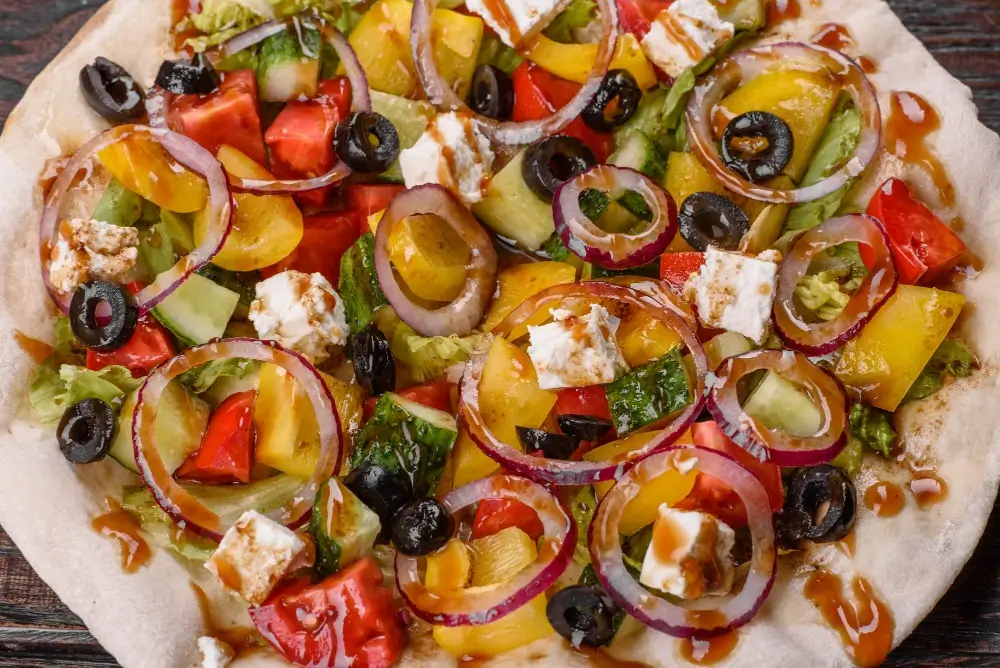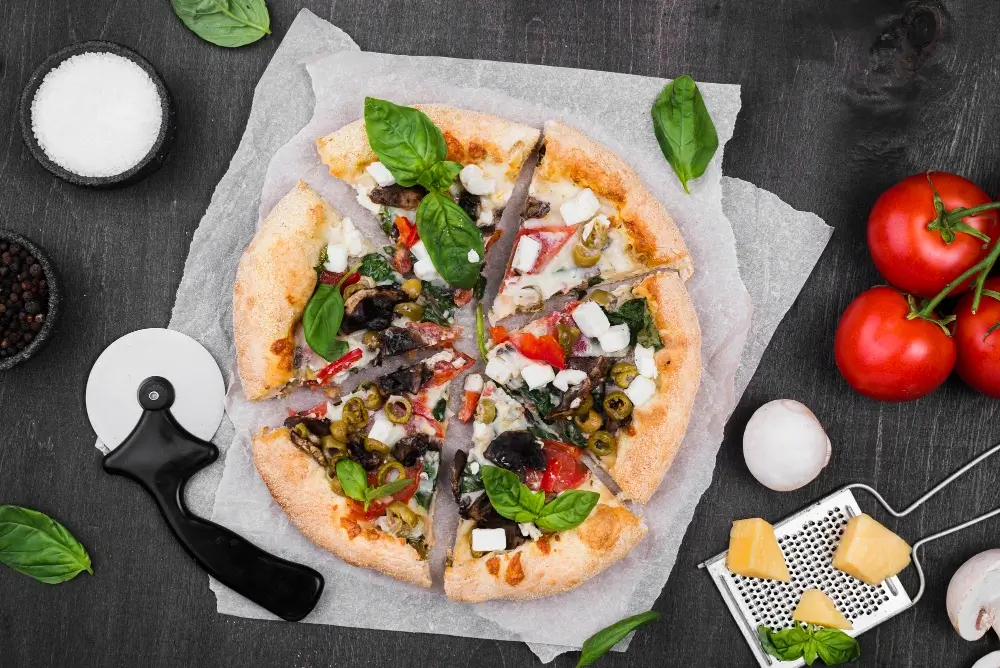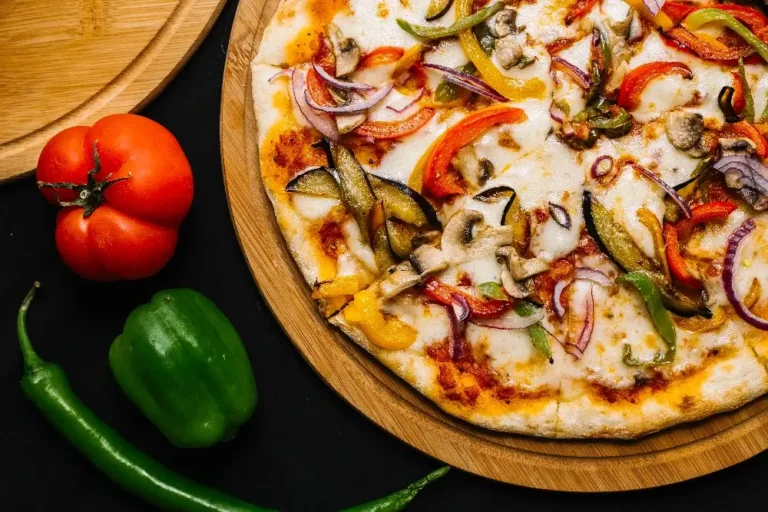Pizza is a beloved dish across the globe. The veggie pizza recipe holds a special place in this culinary universe. It offers a healthier option, caters to vegetarian preferences, and inspires unique toppings. Veggie pizza is both versatile and delightful. This guide covers every step, tip, and secret to crafting the perfect veggie pizza at home.
Why Choose Veggie Pizza?
Veggie pizza isn’t just about skipping meat; it’s a symphony of flavors and textures. From crispy crusts to vibrant toppings, every bite is a celebration. Plus, it’s packed with nutrients, making it a guilt-free indulgence. If you’re looking for inspiration, here’s why veggie pizza should be your go-to choice:
- Packed with vitamins and minerals from fresh vegetables.
- Easily customizable for dietary needs (vegan, gluten-free, or low-carb).
- A fun way to include more veggies in your meals.
Master the Art of Dough Making
Great pizza starts with an excellent crust. Opt for homemade dough to achieve the perfect balance of chewiness and crispiness. Don’t have time to make your dough from scratch? No problem. Store-bought options can also work wonders when prepared properly. Learn how to roll dough efficiently with tips from King Arthur Baking.
Essential Ingredients for Your Veggie Pizza Recipe
Choosing the right ingredients can elevate your veggie pizza to gourmet status. Here’s what you’ll need:
1. The Perfect Base
- Homemade Dough: For an artisanal touch.
- Store-bought dough: Convenient but customizable.
- Crescent rolls: A flaky, buttery alternative (use this guide for tips).
2. Fresh Vegetable Toppings
- Classic options: Bell peppers, mushrooms, onions, and spinach.
- Gourmet picks: Sun-dried tomatoes, artichokes, and heirloom tomatoes.
- Seasonal choices: Asparagus, roasted squash, or fresh corn.
Pro Tip: Pre-cook watery veggies like zucchini or mushrooms to avoid a soggy crust.
Sauce Selection and Baking Techniques for Your Veggie Pizza Recipe
The sauce is the foundation of flavor for your veggie pizza. Pair it with the right baking techniques, and you’ll unlock the full potential of your recipe.
Choose the Best Sauce for Veggie Pizza
The sauce you choose can completely transform your pizza. Here are the most popular options:
- Classic Tomato Sauce
A robust, tangy tomato base is a traditional choice. Use a simple recipe like this one from Delish for the best results. For a twist, consider adding fresh basil or a dash of chili flakes. - Pesto Sauce
If you love earthy and nutty flavors, pesto is a great choice. It pairs well with spinach, artichokes, and mozzarella. Try this arugula pesto recipe for a lighter, peppery variation. - White Sauce
Creamy white sauces, like béchamel, offer a rich, indulgent flavor. Use this for gourmet-style pizzas with toppings like roasted garlic or caramelized onions.
Baking Techniques for a Crispy Crust
Proper baking ensures your pizza is crispy yet tender. Follow these steps for success:
- Preheat the Oven
Set your oven to its highest temperature, typically 475–500°F (245–260°C). A hot oven creates the perfect environment for pizza. - Use a Pizza Stone or Steel
For the crispiest crust, bake your pizza on a heated pizza stone or steel. Preheat the stone for at least 30 minutes to ensure even cooking. Learn more here. - Monitor the Bake Time
Bake for 10–12 minutes, checking for bubbling cheese and golden edges. Adjust the time based on the thickness of your crust.
Tip: Avoid overloading your pizza with toppings. Too much weight can make it soggy.
Customizations for Vegan and Gluten-Free Diets
Creating a veggie pizza recipe that meets dietary restrictions is easy and delicious. Whether you’re avoiding gluten or choosing a plant-based lifestyle, these customizations ensure everyone can enjoy your pizza.
Vegan-Friendly Pizza Options
For a vegan veggie pizza, you’ll need to replace traditional dairy and animal-based products with plant-based alternatives. Here’s how:
1. Vegan Cheese Alternatives
- Opt for store-bought vegan cheese made from cashews, almonds, or coconut oil.
- Nutritional yeast is a great substitute, offering a cheesy, nutty flavor. Learn more about nutritional yeast.
- Make your own vegan cheese. Simple recipes like this one combine cashews and seasonings for a creamy spread.
2. Meaty Veggie Toppings
- Use hearty vegetables like eggplant, mushrooms, and zucchini. These provide a satisfying texture similar to meat.
- Marinate toppings in olive oil, soy sauce, or balsamic vinegar for extra flavor.
3. Plant-Based Sauce Options
- Stick with tomato-based or pesto sauces that use olive oil instead of cream.
- Experiment with hummus or roasted red pepper spreads for unique bases.
Gluten-Free Alternatives
For gluten-free eaters, the crust is the primary consideration. Thankfully, there are many options to explore:
1. Gluten-Free Crusts
- Purchase a pre-made gluten-free crust for convenience.
- Make your own with a blend of almond, coconut, and rice flours.
2. Cauliflower Crust
- A popular gluten-free alternative, cauliflower crust is light and flavorful. Pair it with minimal toppings to keep it crisp.
- You can use pre-made options or learn to make one from scratch (this cauliflower crust recipe is a great resource).
3. Nut and Seed-Based Crusts
- Crusts made from almond flour, ground flaxseeds, or quinoa provide a crunchy base and extra protein.
Pro Tip: Always pre-bake gluten-free crusts for 5–7 minutes to prevent them from becoming soggy during topping and final bake.
Common Mistakes and How to Avoid Them

Making a veggie pizza recipe at home is a rewarding experience, but certain mistakes can lead to disappointing results. Here are the most common errors and how to avoid them to ensure your pizza turns out perfect every time.
Overloading with Toppings
The Mistake
It’s tempting to pile on all your favorite vegetables, but too many toppings can make the pizza soggy and unevenly cooked.
How to Fix It
- Use a balanced mix of vegetables, limiting to 4–5 types per pizza.
- Pre-cook or roast watery vegetables like zucchini, mushrooms, and spinach.
- Distribute toppings evenly to allow for proper cooking and crisping.
Skipping Dough Preparation
The Mistake
Using dough straight from the fridge or failing to let it rest can lead to a tough crust.
How to Fix It
- Allow the dough to come to room temperature before rolling it out.
- Knead the dough thoroughly to develop gluten, ensuring elasticity and softness.
- If you’re short on time, consider using crescent rolls as a base (see more).
Soggy Crust Issues
The Mistake
A soggy crust ruins the texture and makes the pizza less enjoyable.
How to Fix It
- Pre-bake the crust for 5–7 minutes before adding toppings.
- Avoid overloading on sauce and stick to a thin, even layer.
- Use a pizza stone or steel to draw moisture away and create a crispy base (learn how to use one).
Uneven Cooking
The Mistake
A pizza that’s overdone in some spots and undercooked in others can be frustrating.
How to Fix It
- Preheat your oven to 475–500°F (245–260°C) for consistent heat distribution.
- Rotate the pizza halfway through baking to ensure even cooking.
Tip: Using parchment paper can make transferring the pizza to and from the oven much easier.
Pairings and Serving Suggestions for Your Veggie Pizza Recipe
Pairing your homemade veggie pizza with the right sides and beverages can elevate your meal. Whether you’re hosting a gathering or enjoying a quiet dinner, these combinations will enhance the flavors of your pizza.
Perfect Side Dishes
1. Fresh Salads
A crisp salad complements the richness of veggie pizza and adds a refreshing contrast. Try these ideas:
- Simple Green Salad: Toss arugula, spinach, and mixed greens with olive oil, balsamic vinegar, and a sprinkle of Parmesan.
- Caprese Salad: Combine fresh mozzarella, tomatoes, and basil with a drizzle of balsamic glaze.
- Greek Salad: Mix cucumbers, cherry tomatoes, Kalamata olives, and feta for a Mediterranean twist.
2. Roasted Vegetables
Roasted vegetables like carrots and potatoes add a warm, hearty side to your pizza. Check out this guide on roasting potatoes and carrots for inspiration.
3. Dips and Spreads
Pair your pizza with dips for added flavor:
- Garlic Butter Dip
- Herbed Ranch Dressing
- Spicy Marinara Sauce
Beverage Pairings
The right beverage enhances the flavors of your veggie pizza. Consider these options:
- Wine:
- A crisp Sauvignon Blanc or light Pinot Grigio pairs well with veggie toppings.
- If you prefer reds, a light-bodied Pinot Noir complements tomato-based pizzas.
Learn more about wine and pizza pairings here.
- Non-Alcoholic Options:
- Sparkling water with a slice of lemon or lime offers a refreshing touch.
- Herbal iced tea, such as mint or chamomile, cleanses the palate.
- Craft Beer:
- A wheat beer or pale ale provides a balanced, malty flavor to counter the tanginess of tomato sauce.
Desserts to Finish the Meal
End your veggie pizza night on a sweet note with these desserts:
- Cinnamon Roll Glaze: A classic dessert with a rich, sweet topping. Learn how to perfect it.
- Fruit Parfait: Layer yogurt, granola, and fresh berries for a light, healthy option.
- Chocolate Chip Cookie Bars: Make ahead for a chewy, chocolatey finish to your meal.
FAQs About Veggie Pizza Recipe
This section answers the most frequently asked questions about veggie pizza, providing helpful tips and insights for beginners and seasoned cooks alike.
What Vegetables Go Well on a Pizza?
Many vegetables complement pizza, offering a mix of flavors and textures. Popular choices include:
- Bell Peppers: Sweet and colorful.
- Mushrooms: Earthy and umami-rich.
- Spinach: A light, slightly bitter addition.
- Zucchini: Mild and versatile.
- Artichokes: A gourmet option with a tangy flavor.
Feel free to experiment with combinations to suit your taste.
How to Make Veggie Pizza Not Soggy?
Soggy crusts can be a common issue with veggie pizzas. Here’s how to avoid it:
- Pre-cook watery vegetables like mushrooms, zucchini, and spinach.
- Apply a thin layer of sauce rather than overloading it.
- Use a pizza stone or steel to ensure a crispy crust (learn how here).
What Are the Most Common Veggie Pizza Toppings?
Classic veggie pizza toppings include:
- Tomatoes
- Onions
- Bell peppers
- Mushrooms
- Black olives
- Spinach
For gourmet pizzas, try toppings like sun-dried tomatoes, artichokes, or asparagus.
What Vegetables Do Italians Put on Pizza?

Traditional Italian pizzas often feature:
- Zucchini: Often sliced thin and drizzled with olive oil.
- Eggplant: Lightly grilled or roasted.
- Mushrooms: Fresh or sautéed.
- Arugula: Added fresh after baking for a peppery kick.
Veggie Pizza Recipe Variations
Veggie Pizza Recipe with Mayo
Mix mayo with garlic and herbs to create a creamy sauce. Spread it thinly on the crust and top with your favorite veggies.
Veggie Pizza Recipe Cold
Use crescent roll dough as a base and top with a blend of cream cheese, herbs, and fresh, raw vegetables.
Veggie Pizza Recipe with Ranch Dressing Packet
Mix a ranch packet with cream cheese or sour cream for a zesty base. This is ideal for cold or baked pizzas.
What Is the Best Veggie Pizza Recipe?
The best veggie pizza recipe depends on your preferences. A balance of fresh vegetables, flavorful sauce, and the perfect crust is key. For a starting point, try the customizable recipe in this guide
What Is a Classic Veggie Pizza?
A classic veggie pizza features:
- Tomato sauce
- Mozzarella cheese
- Bell peppers
- Onions
- Mushrooms
- Black olives
This combination offers a timeless and well-loved flavor profile.
Nutritional Facts of Veggie Pizza Recipe
One of the biggest advantages of a veggie pizza is its nutritional value. Packed with fresh vegetables, this pizza is a wholesome meal option. Below is a breakdown of the approximate nutritional content per serving (one slice) of a standard veggie pizza made with traditional ingredients.
| Nutrient | Amount per Serving | % Daily Value |
|---|---|---|
| Calories | 200–250 kcal | 10–12% |
| Protein | 8–10 g | 16–20% |
| Carbohydrates | 30–35 g | 10–12% |
| Dietary Fiber | 3–5 g | 12–20% |
| Fats | 8–12 g | 10–18% |
| Saturated Fats | 3–5 g | 15–25% |
| Sodium | 400–500 mg | 17–22% |
| Calcium | 150–200 mg | 12–15% |
| Vitamin C | 15–20 mg | 18–25% |
Note: Nutritional values vary depending on toppings, crust, and cheese types used. For vegan or gluten-free versions, adjust values accordingly.
Why Is Veggie Pizza a Healthy Option?
Veggie pizza is rich in vitamins, fiber, and antioxidants thanks to its vegetable toppings. Here’s a closer look:
- Bell Peppers: High in Vitamin C and antioxidants.
- Mushrooms: A source of Vitamin D and selenium.
- Spinach: Contains iron, calcium, and Vitamin K.
- Tomatoes: Provide lycopene, a powerful antioxidant.
By choosing whole-grain crusts and plant-based cheeses, you can further enhance the nutritional value.
Craft Your Perfect Veggie Pizza Recipe
Creating a delicious and healthy veggie pizza at home is easier than you think. With the right ingredients, preparation techniques, and customizations, you can enjoy a flavorful meal that’s tailored to your preferences. Whether you prefer a classic tomato sauce base, a gourmet white sauce, or a vegan-friendly pesto, the possibilities are endless.
Remember to:
- Use fresh, high-quality vegetables like bell peppers, mushrooms, and spinach for the best flavor.
- Experiment with crusts, from traditional dough to gluten-free and cauliflower-based alternatives.
- Pair your pizza with sides like roasted potatoes and carrots or a crisp salad.
Pro Tip: For a twist, try a cold veggie pizza using crescent rolls as a base. It’s quick, unique, and perfect for summer gatherings. Explore the details in this crescent roll veggie pizza recipe.
Ready to Get Cooking?
Start your journey toward perfecting the ultimate veggie pizza today. Dive into our homemade dough recipe or explore unique topping ideas with this guide to Mediterranean pizzas.
Are you inspired to make your own veggie pizza? Share your favorite topping combinations and customizations in the comments below. Don’t forget to check out other quick and delicious recipes on 30-Minute Recipes for more culinary inspiration.

Related Articles to Explore:
- Spinach and Feta Grilled Cheese – Perfect for pairing with veggie pizza.
- Cinnamon Roll Glaze – A sweet way to end your meal.
- Easy Breakfast Burrito Recipe – Another quick and satisfying recipe to try
for Further Learning:
- Nutritional Benefits of Vegetarian Pizza
- How to Store Leftover Pizza
- Secrets to a Crispy Pizza Crust
Enjoy experimenting and making this veggie pizza recipe your own! If you loved this guide, bookmark it and share it with fellow pizza enthusiasts.

